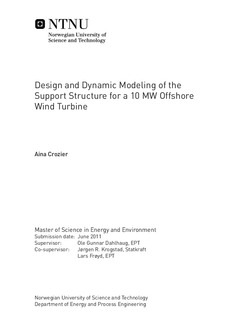Design and Dynamic Modeling of the Support Structure for a 10 MW Offshore Wind Turbine
Master thesis
Permanent lenke
http://hdl.handle.net/11250/234375Utgivelsesdato
2011Metadata
Vis full innførselSamlinger
Sammendrag
This thesis presents two designs of tension-leg-platforms (TLP) support structures for the 10 MW reference wind turbine being developed by the Norwegian Research Centre for Offshore Wind Technology (NOWITECH). The designs result from iterative design processes which account for important design considerations such as performance requirements, natural frequencies and main cost drivers, and differ in their capability of providing stability to the wind turbine. TLP Towed is stable during towing and operation, whereas TLP Transported only provides stability when installed and is dependent on alternative transportation methods. The design processes are validated by investigating the influence from the various requirements and the sensitivity to wind turbine properties. The two resulting designs are compared and discussed in terms of cost competitive advantage. Fully coupled time-domain aero-hydro-servo-elastic models are established in FAST by using hydrodynamic computations from WAMIT, and the models are verified by comparisons to previous time-domain results and frequency-domain calculations. The natural frequencies of the FOWTs are obtained by model linearizations, and a discussion regarding overlap with wind turbine operational frequencies and wave excitation frequencies leads to modifications to the preliminary designs. A number of simulations with different wind and wave conditions are run and the TLP designs are compared based on displacements, upwind and downwind tether tensions, the nacelle's velocity and acceleration and extreme events. Resonant behavior, damping and instabilities are also discussed and suggestions for improvements to the designs are presented. The results presented in this thesis serve as guidance in the process of developing optimized TLP designs for an offshore wind turbine.
